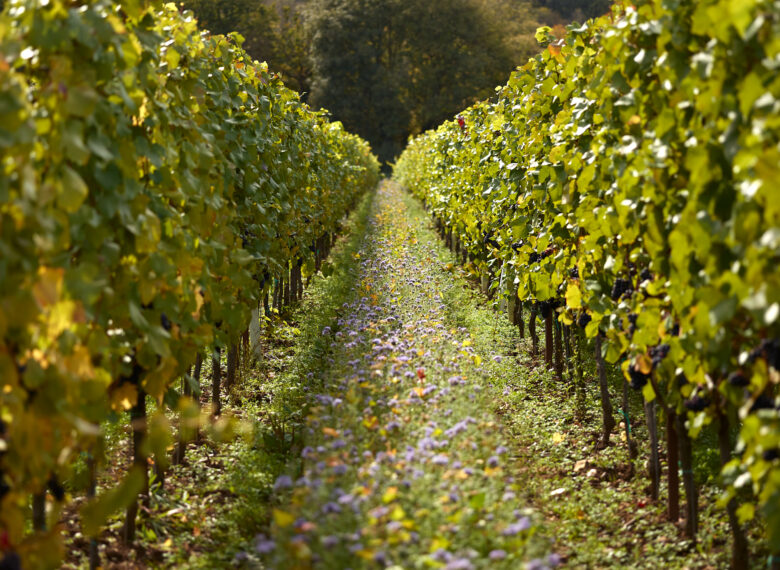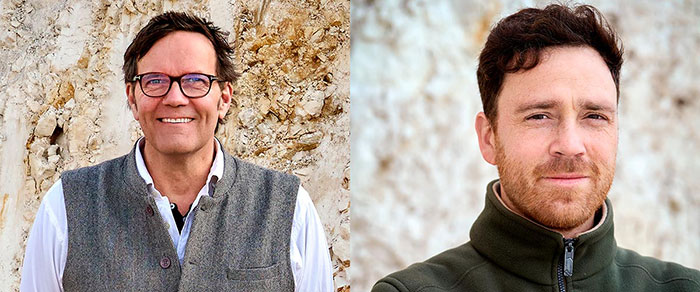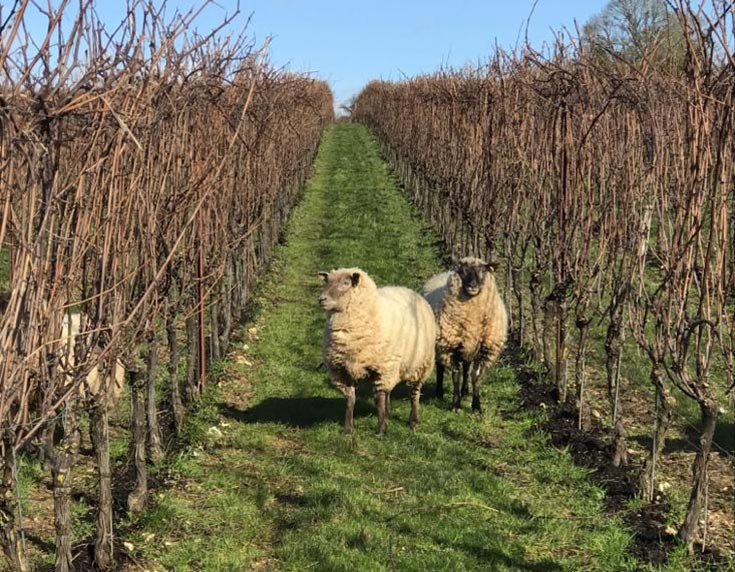
Back to their roots at Burges Field
Simon Mason, Head of Wine Sustainability at The Wine Society, wrote the following on regenerative viticulture at The Grange
Change can be slow in the world of wine, with tradition a major selling point for many. The annual cycle around the one precious crop of grapes understandably means a reluctance to throw caution to the wind with dramatic experiments.
For all that, new ideas do come around, and last year I wrote about the beginnings of a new movement focusing on regenerative viticulture – improving soil health and biodiversity to produce healthy, more disease-resistant grapes – and potentially, better wine.
Zam Baring, managing partner of The Grange and its vineyard Burges Field, and vineyard manager Samuel Philippot were at several of the same conferences I attended on this subject, and I was delighted to visit them to see their work for myself.

The Grange is situated on a chalky slope above the River Itchen in Hampshire, planted in 2011 to classic sparkling-wine grapes – chardonnay and pinots noir and meunier. The gravelly clay soil is incredibly shallow and the vine roots dig down deep into a thick layer of pure white chalk.
When I visited in April, on a cold, blustery day, it was hard to believe that Samuel was expecting budburst to begin the following week. That said, the bougies (candles) already laid out as a precaution against damaging frost were a reminder of the still marginal nature of winemaking in many areas of the UK.
Originating in Montpellier in the south of France and arriving at The Grange five years ago after managing a Bordeaux domaine, Samuel gamely says he greatly enjoys the English way of life. Starting in 2014, Zam and the rest of the small team trialled several different cover crops throughout the vineyard. A cornerstone of regenerative agriculture, cover crops can be used to improve soil texture and water retention through breaking up compaction, improving nitrogen content in the soil without adding fertilisers and potentially, by helping the soil store carbon.
A question of trial and error
As those in regenerative agriculture are at pains to point out, there is no recipe book for success in taking this approach – lots of trial and error will be necessary. Over the years, the team at The Grange have experimented with clover, various species of grass, phacelia, buckwheat and oxeye daisy – one of the ongoing issues being that as you mow so the wildflowers die down and the perennial grasses assert their dominance. As they themselves admit, there was a great deal of experimentation with this and, so far, they have yet to find the perfect mix.
Another principle of regenerative agriculture is to minimise the disturbance of the soil and thereby the communities of bugs, fungi and microbes that make it all work. The Grange’s next trial was to stop any cultivation underneath 20 rows of pinot noir down the centre of the vineyard. After four years the yields from the trial plot had dropped significantly with current vines only able to produce one cane from which new grapes can grow – as opposed to the two canes in the rest of the vineyard. While some drop in yield would have been acceptable to the team, in exchange for healthier vines and more consistent volumes, this was too much and so the trial plot has been reduced in size and the rest of the vines are being cultivated back to health.
Zam and Samuel believe the thin chalk soils are going to need a lot more activation before zero-disturbance will work here. That said, Zam was quite happy with some aspects of the trial plot. In the very difficult, wet 2021 vintage, the reduced vigour of the canopy leaves meant that there was more airflow through the vines and therefore no mildew, which was a big problem on the conventionally farmed plots. The quality of fruit was also excellent.
To build on the work so far, Zam and Samuel are putting together a more structured programme both in the trial plot and across the vineyard. From this year, a cover crop mix of vetches, oats, radish, buckwheat, clover, sunflower, linseed and native wild flowers will be applied. Intended to be self-seeding, this should only need resowing every three or four years, with the cover crop mown or crimped to help return the nutrients to the soil. With plants of differing heights growing at different rates, there is definitely a concern about airflow reduction.
Fauna and flora

Alongside cover crops, the team hopes to make more use of sheep in the vineyard. Winter grazing adds valuable nutrients back to the soil via manure and they can also help with ‘bud rubbing’ – the removal of unwanted buds on the lower parts of vines, sending all the energy into the shoots. This is already practised in other English vineyards, but the low height of The Grange’s vines means that the Ouessant sheep used elsewhere might do more harm than good. Samuel also plans to use fleeces on the ground to help with weed prevention.
Around the back of their brand-new winery, Samuel is developing another vital but less glamorous piece of the regenerative jigsaw – the compost heap. Horse manure and marc, the grape skins leftover after pressing, will be supplemented with mulched cuttings. The aim is to create a high-potency super compost that can be applied more thinly, resulting in fewer tractor passes through the vineyard and helping reduce both carbon emissions and soil compaction.
Does it work?
The team will be taking frequent soil measurements across 40 sample plots identified by GPS, testing things like earthworm count, rooting depth, presence of rhizosheaths and nodulation of legumes – all signs of healthy soil.
Speaking to Zam and Samuel, it is clear that they are committed to a regenerative approach and that it is likely to take many years to show progress. Given that five years is only five chances to see the results of change on the finished fruit and that every vintage brings many variables of its own, the challenges are obvious. “It’s very slow but it’s a direction of travel” says Zam, who plans to do the most he can without affecting the quality of his wines which is great news for our members. We look forward to updating on his progress.







